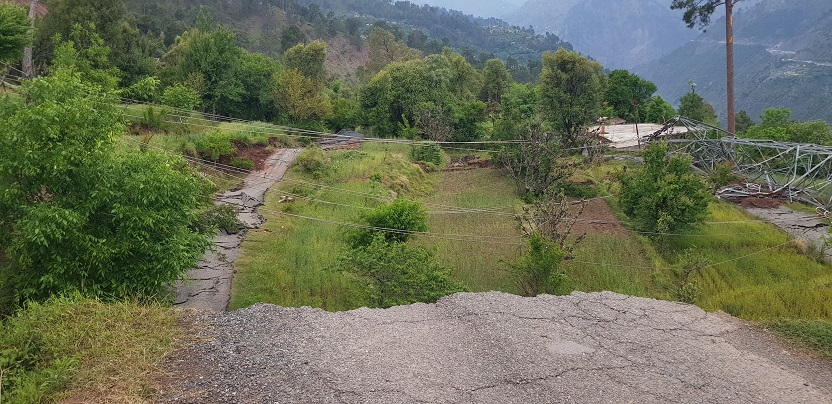
Srinagar- On a calm April 25 evening at around 5 PM, Nadeem Iqbal and his family were gathered for a leisurely tea session at their home in Pernote village of Ramban. Suddenly, they were startled as cracks started to snake their way across the walls of their room. Initially baffled, they momentarily mistook it for an earthquake, but as the fissures rapidly spread, they quickly evacuated the house.
“When we came out, we witnessed chaos engulfing the village. Everyone was rushing towards safety,” Iqbal recalled.
Iqbal saw at least 25 houses damaged that day including his own. The government said over 60 residential houses received major cracks, forcing nearly 500 people to relocate.
“Majority of these houses are inhabitable now,” Iqbal said, adding, “It was so heartbreaking.”
Pernote village, known as the most picturesque in the district, lies approximately seven kilometers from the Deputy Commissioner’s Office in Ramban on Gool-Sangaldan road. Most of the residential houses are built on a hillock, making them more susceptible to landslides. Ramban township is located on the right bank of the Chenab river and the national highway.
According to Iqbal, the affected area spans approximately six to seven kilometers in length and two to three kilometers in width. The sinking originated from the base, approximately 50 meters from the Chenab River.
A local news agency quoted officials saying that the area is continuously sinking and one evening if the sinking is recorded 10 meters, the next morning it becomes 20 meters. The area has loose soil with minimal rocks and water is also present inside which was witnessed by the officials as well.
Over the last more than 10 years Ramban has seen massive infrastructure projects including construction of a four-laning project that connects Kashmir with the rest of the country, 1,850 MW Sawlakote hydel power project, and Udhampur-Srinagar-Baramulla Rail Line (USBRL) project. Locals say that dynamite blasts and hill cutting for building roads and power projects have shaken the mountains.
“ At least four tunnels have been constructed piercing the mountains and extensive blasting was carried out. Entire area has become prone to land subsidence,” said Bashir Ahmad Magray, another resident of Ramban.
He said that the entire region is mountainous and that it was shaken with blasting and other developmental projects.
The landslides, according to locals, typically occur during the rainy seasons, the water is commonly the primary factor. Slides frequently follow periods of heavy rainfall.
According to a study,more than half of the Jammu region including Reasi, Poonch, Ramban, Doda, and Kishtwar is classified as moderate to high-risk zones and these areas are more vulnerable to earthquakes because of the centrally positioned Main Central Thrust and Udhampur Fault in the Region.
The study titled “Seismic Response and Vulnerability Evaluation of Jammu Region” was conducted in 2022 by a group of scholars.
These locations, according to the study, are vulnerable to damage from either near-field or far-field earthquakes due to their “fragile subsurface strata”.
The locals maintain that while they aren’t against the development, it should not come at the cost of the environment and the lives of the people.
“For years the concerned agency that has been entrusted with the construction of National Jammu Srinagar National highway has been dumping the waste material exactly on the opposite side of Pernote village where the incident occurred,” said Iqbal.
He said that all traffic between Jammu and Srinagar travels on this road, increasing the pressure on the mountains.
“The soil in the region is loose. The hydroelectric projects are causing water seepage into the mountains and subsequent land sinking,” said Naresh Kumar, a resident of Ramban.
Anmol Ohri, a Jammu-based climate activist, argues that these incidents reflect something amiss regarding mega infrastructure development works or human intervention.
“..now the problem is the government isn’t making people aware about the consequences and what people need to do. There is no clarity or transparency, thus more panic,” said Ohri, who heads Climate Front Jammu.
He further said that his NGO is dispatching a team of experts to understand the reason behind the incident.
While the government has also dispatched geological experts to understand the cause of the landslide, the locals argue that such surveys have been conducted in the past and the reports are yet to be made public.
Notably, in February 2023, the government had to shift over nineteen families after around 21 structures developed large cracks due to the sinking surface in the Chenab valley’s Doda district.
The government then constituted a committee to understand the reason for the land sinking.
An official from the geology department of the Jammu and Kashmir told Kashmir Observer that the soil is red, loose and sandy with very high moisture in the Pir Panchal and Chenab region. He said that the rate of soil erosion is very high and road blockage is frequent during the rainy season.
“But we can take precautions and avoid major tragedies and disasters in advance,” he said, adding, “Landslides can be forecasted 100 percent.”
With limited land, he emphasized that extensive tree planting, efficient drainage systems, and tackling the root causes of environmental issues are crucial for sustainable living.
Follow this link to join our WhatsApp group: Join Now
Be Part of Quality Journalism |
Quality journalism takes a lot of time, money and hard work to produce and despite all the hardships we still do it. Our reporters and editors are working overtime in Kashmir and beyond to cover what you care about, break big stories, and expose injustices that can change lives. Today more people are reading Kashmir Observer than ever, but only a handful are paying while advertising revenues are falling fast. |
| ACT NOW |
| MONTHLY | Rs 100 | |
| YEARLY | Rs 1000 | |
| LIFETIME | Rs 10000 | |











